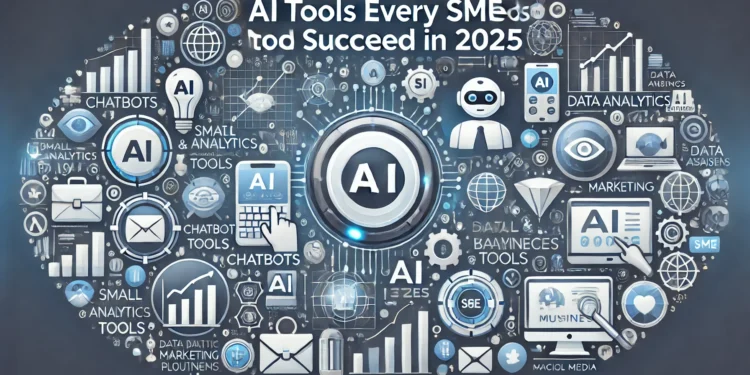What if you could revolutionize how your business operates without adding more stress or time to your plate? For small and medium-sized enterprises (SMEs), AI offers the ultimate competitive edge. Once considered tools for tech giants, AI technologies have become increasingly accessible, empowering SMEs to achieve more with fewer resources.
From automating repetitive tasks to analyzing complex data, AI tools can transform how businesses run, allowing them to focus on growth, innovation, and customer satisfaction. This guide delves deep into the AI tools every SME should embrace in 2025 to stay ahead of the curve.
AI Tools Every SME Should Use to Stay Ahead
Now, let’s explore some top-of-the-line AI tools every SME must have this year. This list is not an actual list of tools but the type of tools you must have:
1. Transform Content Creation with AI
Creating high-quality, engaging content consistently is one of the biggest hurdles for SMEs. Whether you’re working on blog posts, social media campaigns, or email newsletters, staying creative and productive can be tough. This is where AI tools like Jasper.ai, Grammarly, and Canva AI come in.
Jasper.ai helps generate well-written content in minutes. Need a blog post draft or a compelling caption for your next Instagram post? Jasper can take care of that, tailoring content to fit your brand’s unique tone and style. It’s like having a virtual assistant who never runs out of ideas.
Grammarly goes beyond simple spell checks—it enhances your content by improving sentence structure, tone, and clarity, ensuring your message resonates with your audience.
For visual content, Canva AI integrates AI-powered design capabilities, allowing you to create stunning graphics with minimal effort. From templates to smart design suggestions, it enables SMEs to deliver professional-looking visuals without hiring a graphic designer.
2. Automate and Optimize Social Media Management
Social media is a powerful tool for growing your brand, but managing multiple platforms can be overwhelming. AI-powered tools like Hootsuite Insights and Buffer AI simplify social media management, allowing you to schedule posts, track performance, and analyze engagement—all from a single dashboard.
Hootsuite’s AI features help businesses identify the best times to post, understand audience preferences, and even suggest trending content ideas. This ensures your social media strategy remains relevant and impactful without consuming hours of your time.
By incorporating AI marketing tools into your social strategy, you can maximize your online presence while focusing on other aspects of your business.

3. Boost Website Performance with SEO Tools
Search Engine Optimization (SEO) remains a critical element for attracting organic traffic. However, keeping up with ever-changing algorithms and best practices can be a challenge. Tools like SurferSEO, Semrush AI, and Ahrefs AI provide data-driven insights to help optimize your website and content for search engines.
These tools analyze your existing pages, identify gaps, and recommend actionable steps to improve rankings. For instance, SurferSEO offers real-time suggestions while you write, ensuring your content aligns with what search engines prioritize.
By leveraging these tools, SMEs can achieve higher search rankings, attract more visitors, and convert traffic into loyal customers—all without needing in-house SEO expertise.
4. Supercharge Customer Relationship Management (CRM)
Strong relationships are the foundation of any successful business, and AI-powered CRM tools like HubSpot and Salesforce Einstein are game-changers in managing these relationships.
HubSpot’s AI features analyze customer behavior to deliver insights that help you tailor your marketing, sales, and service strategies. Meanwhile, Salesforce Einstein uses predictive analytics to anticipate customer needs, allowing you to personalize your interactions.
For businesses focused on expanding their reach, integrating AI-powered B2B marketing strategies into CRM systems can enhance lead generation, improve customer retention, and increase revenue.
5. Simplify Communication and Team Collaboration
Effective communication is key to running a successful SME, especially as many businesses adopt hybrid or remote work models. AI tools like RingCentral and Slack AI make collaboration seamless.
RingCentral’s AI-powered platform offers features like automatic transcription of meetings, real-time translation, and intelligent call routing, ensuring your team stays connected and productive. Slack AI, on the other hand, helps organize conversations, automate routine tasks, and provide quick answers to common questions, boosting overall efficiency.
These tools not only improve internal collaboration but also enhance customer communication, making them indispensable for SMEs in 2025.
6. Leverage Video Content for Maximum Engagement
Video content is king, and it’s here to stay. AI tools like Lumen5 and Pictory.ai make creating video content easier than ever.
Lumen5 allows you to turn blog posts into engaging video snippets, ideal for sharing on social media or embedding in emails. Pictory.ai focuses on video editing, letting you convert raw footage into professional-looking videos with minimal effort.
For SMEs looking to stand out, video content can capture attention like no other medium. These tools make it possible to create impactful videos without needing advanced editing skills or a large budget.
7. Offer Superior Customer Support with AI Chatbots
Providing excellent customer service can be resource-intensive, especially for SMEs with small teams. AI chatbots like MobileMonkey and Zendesk AI provide a scalable solution, enabling businesses to offer 24/7 support without breaking the bank.
These chatbots handle common queries, assist with product recommendations, and even upsell services, all while maintaining a personalized experience. This not only enhances customer satisfaction but also frees up your team to focus on more complex tasks.
For SMEs, AI chatbots are a cost-effective way to improve customer service and drive sales.
8. Harness the Power of Data Analytics
Data holds the key to smarter business decisions, but analyzing it can be overwhelming. AI tools like IBM Watson Analytics and Google Looker make it easy to extract insights from complex datasets.
IBM Watson uses AI to identify patterns and predict future trends, enabling SMEs to make proactive decisions. Google Looker offers intuitive dashboards that make data visualization simple and accessible, even for non-technical users.
By embracing data analytics, SMEs can uncover hidden opportunities, optimize processes, and stay ahead of competitors.
9. Automate Marketing Campaigns for Better ROI
Running effective marketing campaigns often requires significant time and resources. Tools like ActiveCampaign and Marketo Engage use AI to automate email marketing, audience segmentation, and campaign tracking.
These platforms allow SMEs to engage with customers at the right time with the right message, leading to higher conversions and better ROI. By automating routine marketing tasks, businesses can focus on strategy and growth.
10. Adopt All-in-One AI Platforms for Efficiency
For SMEs looking to streamline operations, all-in-one AI platforms like Zoho AI and Microsoft 365 Copilot offer comprehensive solutions.
Zoho AI integrates across functions like accounting, project management, and customer support, creating a centralized hub for your business operations. Microsoft 365 Copilot leverages AI to assist with tasks like drafting documents, analyzing spreadsheets, and managing emails, saving time and reducing manual effort.
By adopting these platforms, SMEs can enhance productivity while minimizing costs.
Must Read the Story: Accidents Caused by Distracted Drivers: Legal Steps to Take
Conclusion
AI tools are no longer futuristic innovations—they’re practical solutions that SMEs can use to thrive. From creating content to managing customers, these technologies are designed to make businesses smarter, faster, and more efficient.
The future of business belongs to those who adapt. By embracing AI tools, SMEs can not only keep up with the competition but also lead the way in innovation and growth. Don’t wait—start integrating these tools today and position your business for success in 2025.













